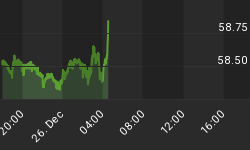Recent reports of better than expected job growth and a 3.9% gain in 3rd quarter GDP have spawned much talk about how the resilience of the American consumer is enabling the country to weather the subprime storm. In reality, the unfolding financial crisis on Wall Street is in fact a direct result of the deteriorating economic conditions on Main Street.
The recent rosy GDP data was made possible only by reporting annualized inflation for the quarter at the absurdly low .8%. This historically low inflation rate makes nominal GDP gains appear to be substantive. Similarly, the October payroll report relied on significant job growth that the government claims took place in construction and financial services! Given all the job cuts in these two sectors, such assumptions are clearly absurd, and paint an unrealistically sunny picture of the U.S. employment landscape.
The problems for the major financial firms such as Citigroup and Merrill Lynch are rooted in Main Street's inability to repay mortgages, and the fact that many homes are worth less than their underlying loans. With housing prices falling, adjustable rates resetting higher, lending standards tightening, credit card debt mounting, and wage growth failing to keep pace with living costs, the American consumer is finally reaching the end of his rope. Without the ability to take on additional debt, he simply can no longer keep spending.
As Wall Street is beginning to fess up to huge losses, similar "write-downs" are becoming evident on Main Street. Just like the big banks padded earnings by collecting large fees on securitized loans they knew were riskier than advertised, U.S. GDP has been padded by consumers spending borrowed money. As the debts mount and servicing costs soar, there is simply no way for consumers to keep spending. Just like Wall Street's past profits sowed the seeds of today's losses, the boost to past GDP provided by excess consumption will lead to big declines in future GDP.
The dramatic collapse of the U.S. dollar, and the Fed's failure to respond, provides fresh evidence of American economic weakness. If the Fed believed that the economy was as strong as government statistics suggest, it would have the flexibility to reverse the dollar's decline. The only reason for their inaction is that the Fed is willing to accept higher inflation and a weaker dollar to contain the recessionary forces clearly building on Main Street.
Despite Ben Bernanke's testimony before Congress, in the long run domestic prices are determined by the value of the dollar. The weak dollar does not only affect tourists or the price of imports, but the price of all goods, regardless of where they are produced. All domestic producers have the ability to export their production. As the dollar falls, American consumers are forced to pay higher prices to dissuade them from doing so.
The dollar's fall is now so pervasive that the world is walking away from it en masse. The story has even been given some sizzle with the announcement from Brazilian supermodel Gisele Bundchen that she will no longer accept modeling contracts in dollars. Never seeing a cloud attached to any silver lining, knee-jerk bulls such as Larry Kudlow have suggested that Bundchen's decision is a contrary indicator that the dollar has bottomed. In truth, the only notable bottom here belongs to Gisele herself.
Supermodels are not traders and her dollar bearishness should not be confused as a legitimate contrary indicator of market sentiment. Her demands simply reflect a rational decision not to be paid in a currency that's future value is in doubt. Gisele's lack of confidence in the dollar is symptomatic of a serious problem, especially since confidence is the only backing the dollar has. Should Gisele's concerns become the equivalent of a new fashion trend, the problems on Main Street are about to get a lot worse.
Despite the fact that my critics (such as Tobin Smith, on Fox News' Bulls and Bears last week) point to phony government statistics to discredit my economic predictions, the actions in the markets continue to validate every single one of my forecasts. For investors, the urgency to divest themselves of U.S. dollar denominated assets has never been greater. Recent comments from a prominent Chinese government official confirm that time to do so is indeed running out.
For a more in depth analysis of the tenuous position of the American economy, the housing and mortgage markets, and U.S. dollar denominated investments, read my new book "Crash Proof: How to Profit from the Coming Economic Collapse." Click here to order a copy today.
More importantly, don't wait for reality to set in. Protect your wealth and preserve your purchasing power before it's too late. Discover the best way to buy gold at www.goldyoucanfold.com, download my free research report on the powerful case for investing in foreign equities available at www.researchreportone.com, and subscribe to my free, on-line investment newsletter at http://www.europac.net/newsletter/newsletter.asp.















